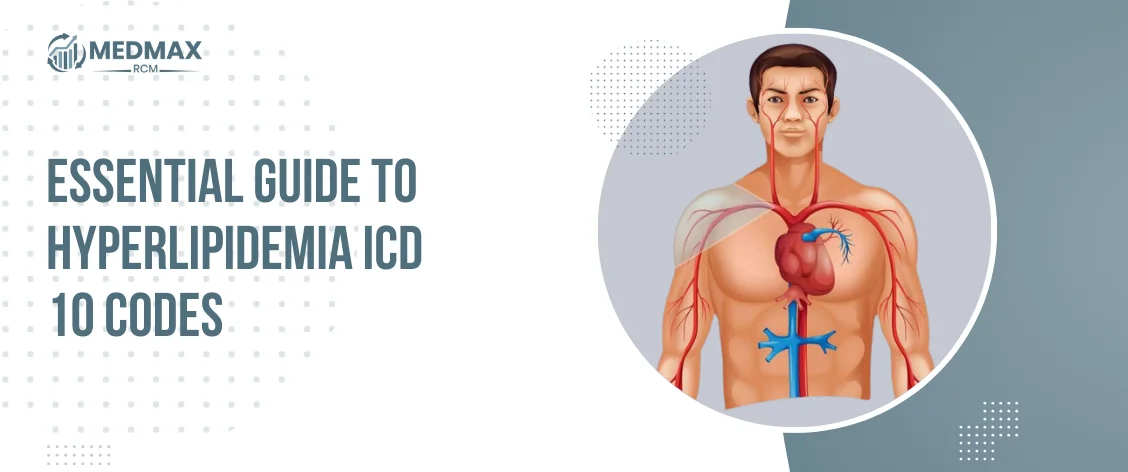
Essential Guide to Hyperlipidemia ICD 10 Codes
Hyperlipidemia (High blood cholesterol) is a major health risk for people around the world. About 94 million adults have cholesterol levels higher than the normal reference range. As a healthcare provider specializing in cardiology, you already know the different health issues that come with high cholesterol.
When you see a patient who may have hyperlipidemia, it is important to document the diagnosis correctly so the patient receives the best care. To do this, you must use hyperlipidemia ICD 10 codes for during the documentation process.
But what exactly are ICD 10 codes for hyperlipidemia? And how do these codes help healthcare providers deliver quality care?
In this article, we will explain the ICD 10 codes for hyperlipidemia and give a complete guide for providers and medical coders to ensure accurate diagnosis coding.
Table of Contents
ToggleWhat is Hyperlipidemia?
Hyperlipidemia, also called high cholesterol, is a medical condition where the levels of lipids (fats) in the blood are higher than normal. These lipids include cholesterol and triglycerides.
Cholesterol is a type of fat that the body needs for important functions like building cell membranes and making hormones. But when cholesterol levels get too high, fatty deposits can build up in the arteries. This increases the risk of heart attack, stroke, and other cardiovascular diseases.
Symptoms of Hyperlipidemia
Hyperlipidemia usually does not cause clear or noticeable symptoms. It is often called a “silent” condition because people with high cholesterol may not feel anything until serious problems such as heart disease or stroke appear.
This is why regular cholesterol screenings are important, especially for people with risk factors like family history of heart disease, obesity, diabetes, or lack of physical activity.
Hyperlipidemia vs Dyslipidemia
Hyperlipidemia and Dyslipidemia both relate to abnormal lipid (fat) levels in the blood, but they are slightly different:
- Hyperlipidemia refers specifically to high levels of lipids, including cholesterol and triglycerides.
- Dyslipidemia is a broader term that means any abnormal lipid level — either high or low.
Providers are advised to use E78.5 as the dyslipidemia ICD 10 code.

What is the ICD 10 code for hyperlipidemia?
For accurate documentation, providers must use the correct hyperlipidemia ICD 10 codes. The recommended code to report hyperlipidemia unspecified is ICD 10 E78.5.
Do I always need to report the E78.5 diagnosis code for Hyperlipidemia?
By now, you know what the hyperlipidemia ICD 10 code is. But E78.5 is not the only code. The ICD 10 code changes depending on the type and complexity of hyperlipidemia.
Is Hyperlipidemia the same as high cholesterol?
Many people think hyperlipidemia and high cholesterol are the same, but technically, they are different.
- High cholesterol means the levels of lipids in the blood are higher than normal.
- Hyperlipidemia is a general term for any condition that involves high levels of lipids in the blood.
Diagnosis code E78.5 is also used as the ICD 10 for high cholesterol.
Types of Hyperlipidemia and Their ICD 10 Codes
Hyperlipidemia has several types, and each one requires a specific ICD 10 code:
Pure Hypercholesterolemia
This condition occurs when cholesterol levels are abnormally high.
ICD 10 Code: E78.00
Familial Hypercholesterolemia ICD 10 Codes
This is a genetic condition that causes very high cholesterol levels due to a gene mutation.
ICD 10 Code: E78.01
Pure Hyperglyceridemia
This condition involves abnormally high levels of triglycerides in the blood.
ICD 10 Code: E78.1
Mixed Hyperlipidemia
This type includes both high cholesterol and high triglycerides.
ICD 10 Code: E78.2
Hyperchylomicronemia
A rare condition with extremely high levels of chylomicrons (fat-carrying particles). It may cause abdominal pain and pancreatitis.
ICD 10 Code: E78.3

How to Diagnose Hyperlipidemia
Hyperlipidemia is usually diagnosed with a lipid panel (lipid profile) blood test.
A lipid panel measures cholesterol, triglycerides, and other fats in the blood. This test gives important information about cardiovascular health and risk of heart disease.
Providers should use Z13.220 as the ICD 10 code for a lipid panel.
Conclusion
Hyperlipidemia is a major risk factor for heart disease and other cardiovascular problems. Proper diagnosis is essential to deliver quality care and ensure correct coding.
Using accurate ICD 10 codes for hyperlipidemia helps healthcare providers document diagnoses properly and supports insurance reimbursement.

Emily Thompson
Emily Thompson is a Revenue Cycle Management (RCM) Specialist with extensive experience in the medical billing industry. She helps healthcare organizations and medical billing companies improve claim efficiency, reduce A/R backlogs, and implement data-driven RCM strategies. Emily’s articles focus on end-to-end medical billing services, denial prevention, and technology-driven revenue optimization for healthcare practices across the U.S.



